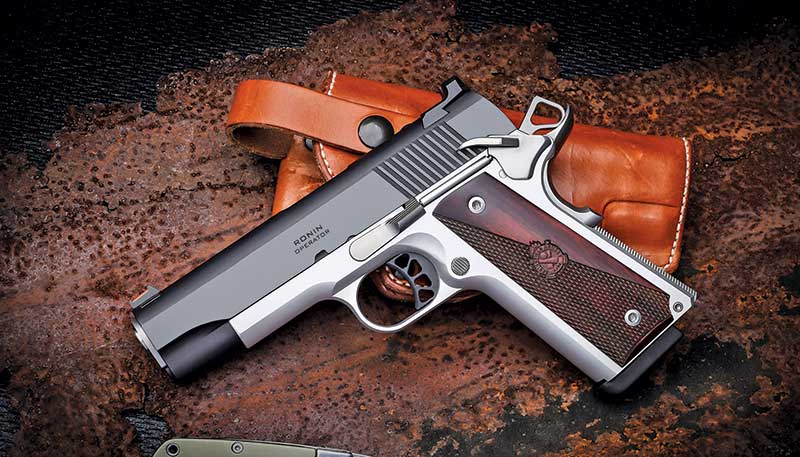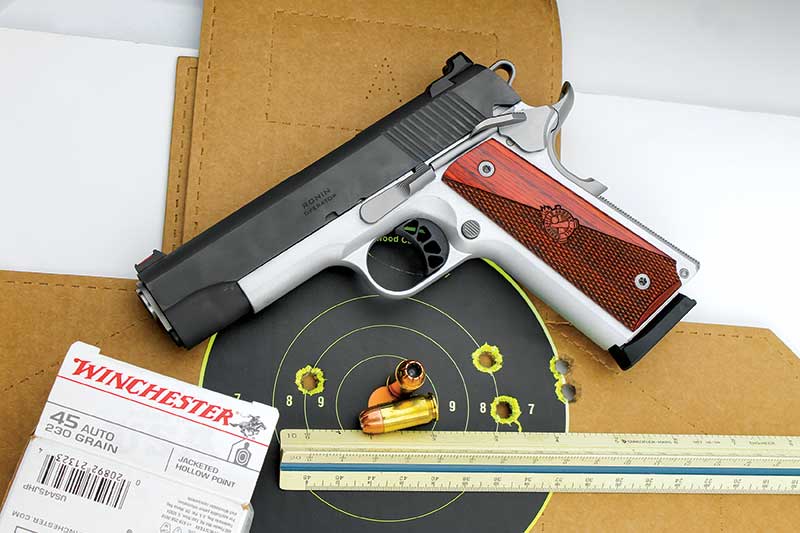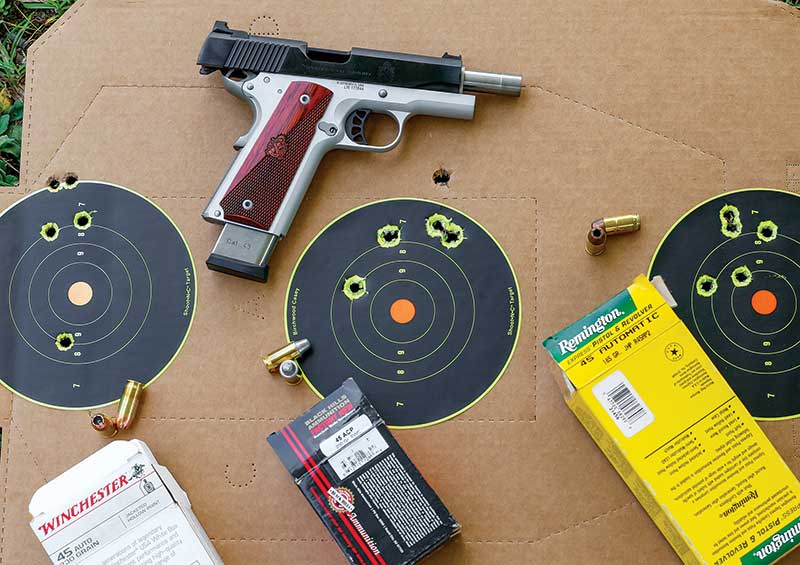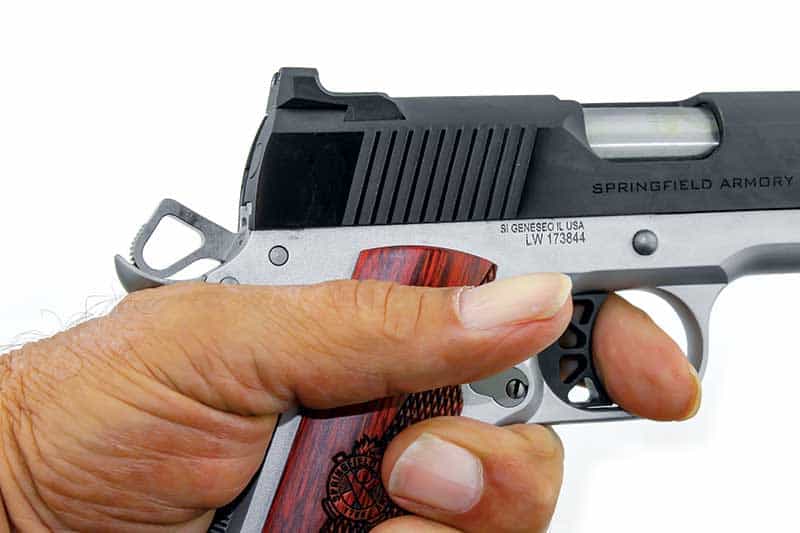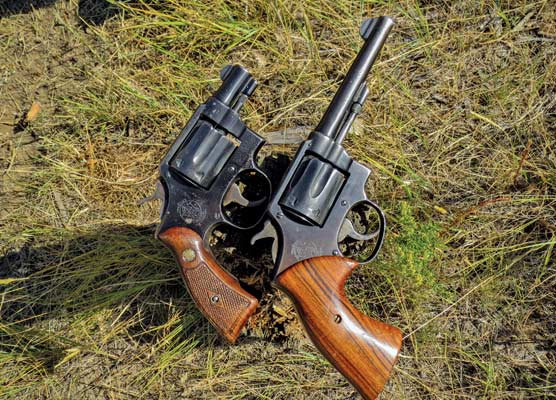Springfield Armory
Ronin Operator
A Short, Light And Smooth Handling Fighting Pistol
Springfield Armory’s recent addition to their 1911 line, the Ronin, offers classic retro styling combined with modern “improved shootability” features. Beginning with the all-steel 5″ barrel gun, the next logical step was the shorter model with 4.25″ barrel and light aluminum frame. It debuts under the Ronin Operator name. You can think of it as an homage to the Colt Commander .45 of the mid-20th Century.
It’s about three-quarters of a pound lighter than the all-steel full-size model, something I appreciate after 60 years with 1911s. It comes with a single-lever thumb safety with positive on and off, beavertail grip-safety and a two-tone nod to the 1980s in finish. It comes with three Mec-Gar eight-round magazines. Sights are excellent: red fiber optic front and a big-notch rear sight with a ledge to allow one-handed slide racking against the belt in an emergency. The magazine well is lightly beveled.
This style of .45 has been with us for 70 years. Cocked and locked (modern Springfield Armory 1911s are drop-safe) and equipped with a properly adjusted grip safety, they’re probably safer to tuck in a waistband than most striker-fired pistols in an emergency when there’s no time to holster up. Think of it as “going commando” with your Commander-style .45 and the nine fat sluggers it has on board to protect you and your family.
Accuracy
I tested with my usual protocol, hand-held on a Matrix rest on a concrete table 25 yards from the target. I measured each group twice, center to center between the farthest-apart shots, to the nearest 0.05″. The first measurement is all five hits, the second, the best three. Experience has shown me and others the all-five measurement gives a good idea what experienced hands can do with the gun and ammo combo under ideal conditions, while the best three closely duplicates what could be expected with all five of the same from a machine rest. Since few of our readers own a Ransom Rest, this is something they can test their own sample with to compare to our results.
The “best three” measurement also helps factor out unnoticed human error, which I suspect was present in our first two groups. I try to test with the three most popular bullet weights for the caliber, and in .45 ACP those are 185, 200, and obviously 230-grain. Choice for the latter was Winchester “white box” JHP, which had a 1.45″ group spoiled by a single errant shot that stretched the measurement to 4.25″ (not necessarily a proper group for a 4.25″ barrel gun; I’m sure the bad shot was on me). The best three of the five hits were in 1.25″, which probably better showed the true accuracy potential of this gun and load.
For 200-grain I chose Black Hills’ LSWC (lead semi-wadcutter hollow point). Its five big holes measured 3.60″ apart, with four of them in 1.65″ and the best three in 1.55″.
The 185-grain proved to be the star of the accuracy show, with Remington’s Express load jacketed hollowpoint delivering a quintet of holes in a 2.05″ cluster, with the best three exactly an inch tighter at 1.05″. This has always been a very accurate load, and while it doesn’t expand as aggressively as some wider-mouth .45 JHPs, it always seems to feed in any gun that runs with ball ammo. With generations of 1911s designed for round-nose full metal jacket cartridges, that’s an important selling point for this Remington round.
Another part of the accuracy picture is point of aim compared to point of impact. For me, the test pistol shot a tad right with everything but was “on” for elevation. Had I kept it, it would have been simple enough to loosen the set screw and drift the rear sight a wee bit to the port side of its dovetail. No big thing.
Handling
I wasn’t able to test it in a class or match for handling under stress (darn pandemic!) so I took the light .45 downrange for drills. It ran consistently on Bianchi plates, six shots for six hits, and then I tried it on a drill developed by one friend and shared by another: Dave Spaulding’s Fade-Back, which I got from Tom Givens. It’s a dozen and a half rounds in three-shot sequences done at 3, 5, 7, 10, 15 and 25 yards. I shot it standing Isosceles. The target is a 3X5 card, and the goal is to keep all 18 rounds “in the white part.” I would normally have taped the card on vertical, but remembering the test pistol had drifted a little to starboard for me from the bench, I placed it horizontal. Not as clever a move as I thought …
The short Ronin gave me a one-hole group out to 10 yards, where it started to open up. At 15, I pulled one high and at 25, one more. I’m pretty sure my subconscious was trying to spot the hit, which causes the head to lift and the gun to lift very slightly with it. I only got 16 hits, which rounded off to 89% (88.888, if you want to put a fine point on it).
Handling
Ironically, the 4.70″ group was dispersed vertically, and had I not put the damn card sideways all the shots would have been “in” with a perfect score. I had done the “hoist by my own petard” thing, but the take-away point is, the pistol itself could have easily delivered a 100% score.
Overall handling? I think the lighter weight makes it quicker from the holster, and the beavertail grip helps guide the firing hand into position at the beginning of the draw. I love the slim grips. This pistol doesn’t have a short trigger per se and the reduced girth improves trigger reach. I was able to get my distal joint to the center of the trigger face, which I find improves my leverage.
The skeletonized trigger had a (desirable) light take-up followed by a very short, smooth roll that brought it to a clean break, with little perceptible backlash. On a Lyman digital gauge, pull weight averaged 5.2 lbs. I’ve found this to be a sweet spot for a “street trigger” in a 1911.
Wooden grip panels, half-checkered in the front in a diagonal pattern, seem to be a signature feature of Springfield’s Ronin series. Along with the checkered (flat) mainspring housing in the back, they gave an adequately solid hold despite the smooth front of the grip-frame. The pistol never shifted in my hand.
As we’ve come to expect with aluminum framed .45s, they kick more. If you’ve shot +P .45 ACP in a steel frame 1911, you’ve had a preview of the push-back and muzzle jump you’ll experience with a lightweight 1911 .45 and standard pressure 230-grain loads. It’s nothing that can’t be handled with a firm grasp and an aggressive forward firing stance.
Bottom Line
In several hundred rounds in various hands, we experienced only one malfunction with the test gun, a failure to feed with hardball. The shooter was a rugged six-footer who looked locked on to me but felt he might have limp-wristed the gun. This was an anomaly in the first 200 break-in rounds and was not repeated. About the only beef anyone had with it was lack of an ambi safety and a sharp edge on the rear of the slide stop, which one straight-thumbs shooter found uncomfortable.
At $849, the expanding Ronin series joins the same maker’s Range Officer series in the “best buy” category in sub-$1K 1911s. It’s also available in 9mm; look for a test of the variation in our sister magazine, GUNS.
For more info: Springfield-Armory.com

